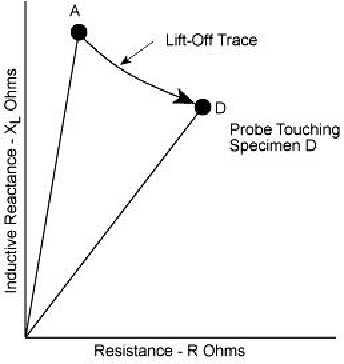T.O. 33B-1-1
4-24
will appear on the display. The spot (null point) can be repositioned near the upper left hand corner of the display, as
indicated by point A in Figure 4-19. The null point in air will be used as a point of reference for the rest of the diagrams.
Next, the ferrite specimen is used to establish the direction of inductive change. Place the probe on the ferrite and
adjust the phase control so that the change from air to ferrite is vertical (parallel to the y-axis). When the probe is
placed on the copper specimen, the point will move to a new location on the screen, represented by point I in the figure.
As the probe is lifted from the specimen, the point will move back to the air null point (A), as shown in Figure 4-19.
The path that the indication follows as the probe is moved onto and off the specimen is called the lift-off trace/line.
Figure 4-19. Vector Representation of an Impedance Change Due to Lift-Off.
4.3.3.2.1
The gain and phase controls can be adjusted to place point I anywhere on the display. Because copper has high
conductivity, it will be convenient to adjust the gain to put point I in the lower part of the screen, as shown in Figure 4-
20. When the probe is placed on the other metal samples, the respective impedance points (B through H in Figure 4-
20) are recorded. Note that for each of the different materials, the point will be located at a different location on the
screen (i.e., each different specimen has a different impedance). Each line from the null point A, to the impedance
point for a particular specimen represents a lift-off trace. If a smooth curve is drawn from the null point (A) through
each of the impedance points (B through I), a conductivity curve will be formed. The point on the curve closest to the
air null point represents the material with the lowest conductivity (titanium, for example). The point on the curve
farthest from the air null point represents the material with the highest conductivity (high purity copper). This diagram
also shows the relative conductivity’s of the other specimens.


